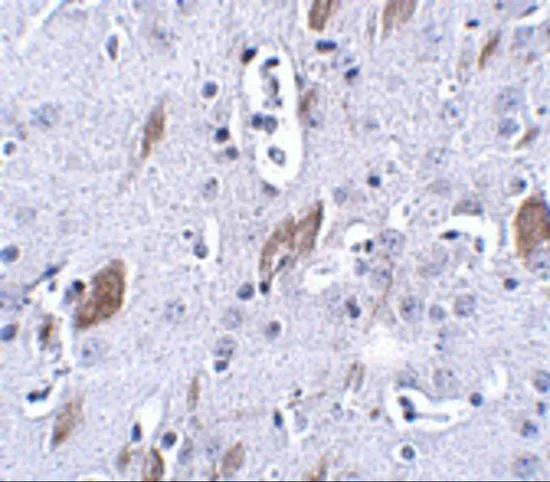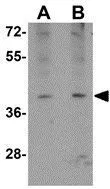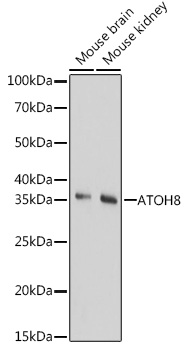
IHC-P analysis of mouse brain tissue using GTX85296 ATOH8 antibody. Working concentration : 5 microg/ml
ATOH8 antibody
GTX85296
ApplicationsWestern Blot, ELISA, ImmunoHistoChemistry, ImmunoHistoChemistry Paraffin
Product group Antibodies
TargetATOH8
Overview
- SupplierGeneTex
- Product NameATOH8 antibody
- Delivery Days Customer9
- Application Supplier NoteWB: 1 - 2 microg/mL. IHC-P: 5 microg/mL. *Optimal dilutions/concentrations should be determined by the researcher.Not tested in other applications.
- ApplicationsWestern Blot, ELISA, ImmunoHistoChemistry, ImmunoHistoChemistry Paraffin
- CertificationResearch Use Only
- ClonalityPolyclonal
- Concentration1 mg/ml
- ConjugateUnconjugated
- Gene ID84913
- Target nameATOH8
- Target descriptionatonal bHLH transcription factor 8
- Target synonymsHATH6, bHLHa21, transcription factor ATOH8, atonal homolog 6, atonal homolog 8, atonal homolog bHLH transcription factor 8, basic helix loop helix transcription factor 6, class A basic helix-loop-helix protein 21, helix-loop-helix protein hATH-6, protein atonal homolog 8
- HostRabbit
- IsotypeIgG
- Protein IDQ96SQ7
- Protein NameTranscription factor ATOH8
- Scientific DescriptionBasic helix-loop-helix (bHLH) transcription factors play important roles in differentiation processes during embryonic development of vertebrates. ATOH8 (MATH6) is a tissue-restricted member of the atonal superfamily of bHLH transcription factors that exhibits 43-57% identity in the bHLH domain with other mammalian atonal paralogs including the NeuroD and Neurogenin factors. In the mouse, ATOH8 has been implicated in the specification and differentiation of neuronal cell lineages in the brain and may also participate in kidney development. Recent studies show that ATOH8 is a novel component of the pancreatic transcriptional network during embryonic development and suggest a potential role as a modulator of the differentiation program initiated by the pro-endocrine factor Neurog3. It is indispensable for early embryonic development, suggesting a more widespread function for this factor in tissue-specific differentiation processes that are dependent on class II bHLH genes.
- Storage Instruction-20°C or -80°C,2°C to 8°C
- UNSPSC12352203





